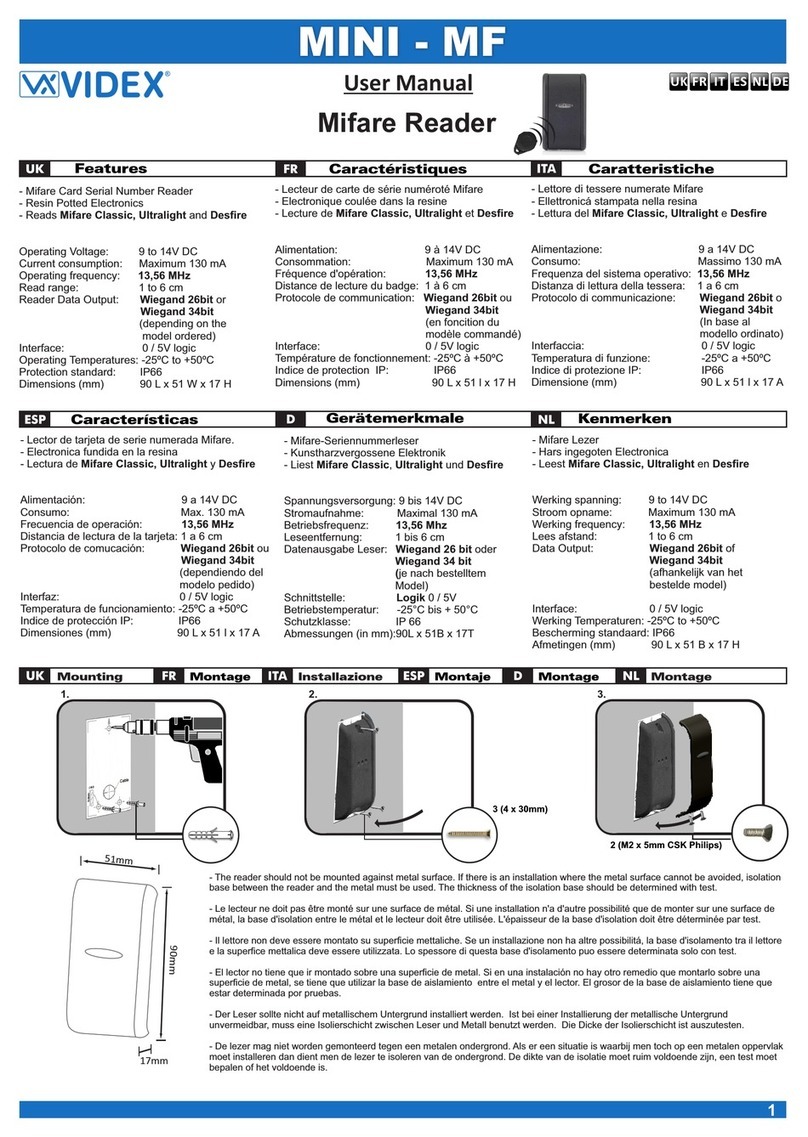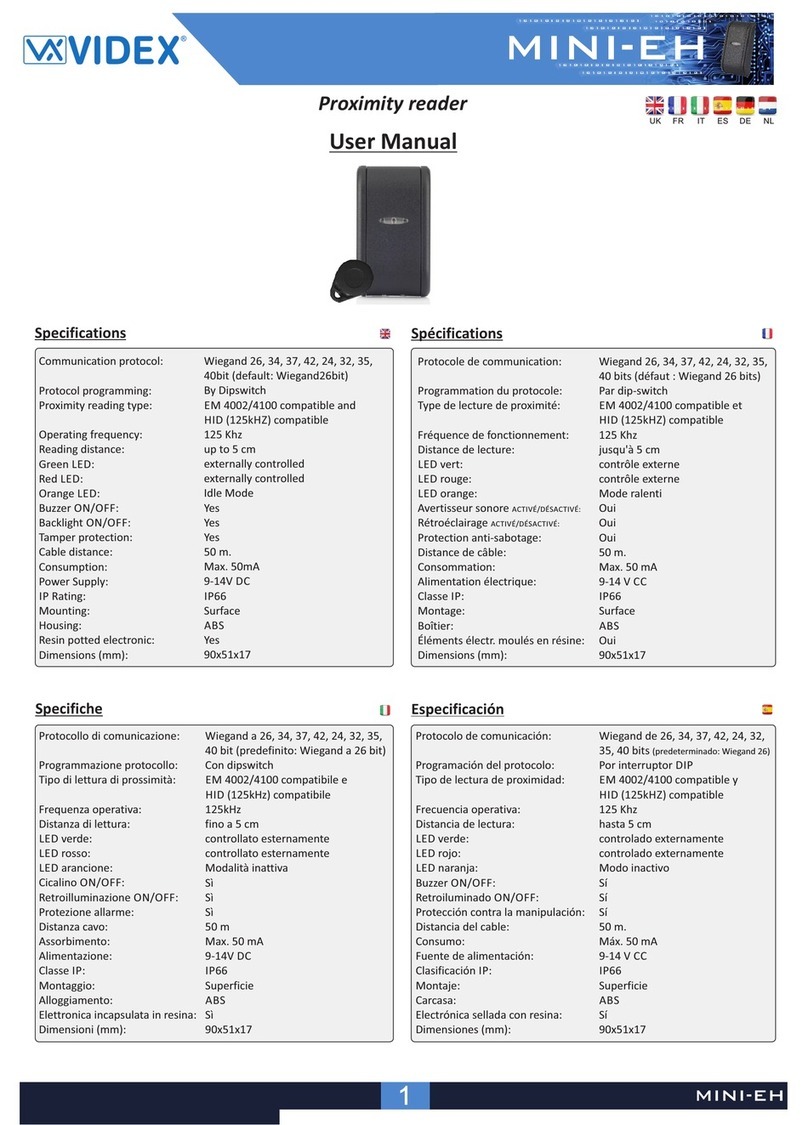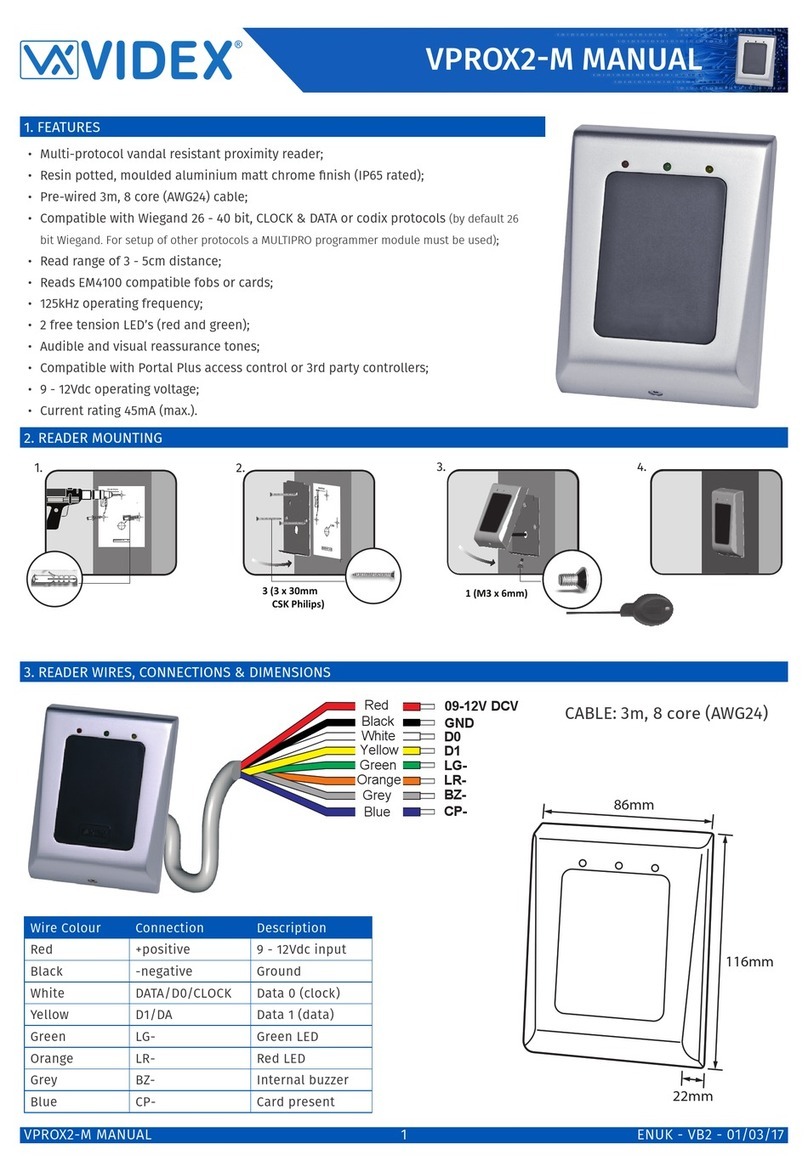
66250400 - V1.3 - 30/09/17
9
Serie 4000
Art.4850 - Istruzioni di installazione
SBLOCCO TASTI
Il blocco dei tasti funge da protezione contro eventuali ma-
nomissioni o pressioni accidentali degli stessi. La sequenza di
sblocco è costituita da una combinazione di 4 pressioni sce-
gliendo tra i tasti “tens”, “units”, “store” e “delete”: lo stesso
tasto può essere presente più volte (max 4) nella combinazione
per cui una sequenza di sblocco può essere composta anche
da 4 pressioni di uno solo dei tasti tra quelli sopra menzionati.
PROCEDURA DI SBLOCCO TASTI:
1. Dalla condizione di “stand-by” (LED verde “store” e LED ros-
so “delete” accesi) inserire la sequenza di sblocco premendo
gli opportuni tasti. In caso di prima programmazione, la se-
quenza impostata di fabbrica è 4volte il tasto “tens”;
2. Se la sequenza inserita è errata, l’unità lo segnala con un bip ed
i LED rosso e verde restano accesi (ripartire dal punto 1) altri-
menti vengono emessi due bip, i LED rosso e verde si spengo-
no e si accendono quelli gialli a segnalare la corretta sequenza;
3. I LED gialli sono accesi e l’unità è in attesa di una nuova se-
quenza di sblocco. Per procedere con lo sblocco dei tasti di-
gitare una nuova sequenza o una uguale a quella preceden-
te. Se la digitazione della nuova sequenza si interrompe per
più di 15 secondi l’unità torna in “stand-by” (punto 1);
4. L’emissionedi2 bip el’accensionedei4 LED (2gialli, il verdeed ilros-
so) indicano che i tasti sono sbloccati (“modoprogrammazione”)
edè possibile accedere ad una delle seguenti operazioni:
a. Memorizzazione di una chiave;
b. Cancellazione di una chiave;
c. Lettura di una chiave;
d. Programmazione del tempo relè.
In assenza di operazioni i tasti si bloccheranno automaticamente dopo circa 20 secondi.
Per uscire dal modo programmazione prima che scadano i 20 secondi di“timeout”, premere per circa 3 secondi il pulsante delete:
il LED store si accende per un secondo circa e l’unità emette un beep con- fermando l’uscita dal modo programmazione.
MEMORIZZAZIONE CHIAVE
La “memorizzazione chiave” consiste nell’abbinare un codice
(1..99) ad una chiave di prossimità. La chiave memorizzata per-
metterà (quando letta) di attivare il relè incorporato nel modulo.
PROCEDURA DI MEMORIZZAZIONE CHIAVE:
1. Se necessario sbloccare i tasti seguendo la relativa procedura per
entrare nel “modo programmazione” (LED gialli, verde e rosso);
2. Premere il tasto “store”, resta acceso il LED verde mentre gli
altri si spengono. L’unità è in attesa di un codice;
3. Digitare il codice (1..99) utilizzando i tasti “units” (unità) e “tens”
(decine): scegliere un codice e premere il tasto “units” tante vol-
te quante sono le unità del codice scelto ed il tasto “tens” tante
volte quante sono le decine. Ogni pressione è confermata da un
bip e dall’accensione del relativo LED. Volendo programmare il
codice 45 è necessario premere “units” 5 volte e “tens” 4 volte;
4. Premere il tasto “store”:
a. Se il codice scelto è occupato, l’unità emette un bip, si ac-
cende per circa un secondo il LED rosso e la programma-
zione torna all’inizio del punto 3;
b. Se il codice scelto è disponibile, il LED verde inizia a lam-
peggiare e l’unità è in attesa della chiave da memorizzare.
5. Avvicinare la chiave al lettore (zona centrale nella parte fron-
tale del modulo) per memorizzarla. Letta la chiave l’unità tor-
na nel “modo programmazione” (LED gialli, verde e rosso
accesi) in attesa di una nuova operazione.
Alimentare l’unità
Digitare la sequenza
di sblocco
Digitare una nuova
sequenza o ripete-
re la precendete
Canc.
chiave
Mem.
chiave
Lettura
chiave
Prog. tempo
relè
Sequenza
corretta?
In caso di prima pro-
grammazione preme-
re 4 volte “tens”
L’unità emette due bip,
LED rosso e verde spenti,
LED gialli accesi
SI
NO
L’unità emette due bip,
i 4 LED sono accesi
I tasti sono sbloc-
cati ed è possibile
passare ad una
delle seguenti
operazioni
Sbloccare i tasti se necessario
Chiave letta, il sistema torna
nel modo prog.
Premere il pulsante store
Inserire il codice tramite i tasti
tens e units
Es. 45 =
4 volte tens
5 volte units
Avvicinare la chiave al lettore
Premere il pulsante store
Codice
occupato?
LED gialli, rosso e
verde accesi
LED verde acceso
l’unità attende un codice
1 bip e LED rosso acce-
so per circa 1 secondo
LED verde lampeg-
giante attesa chiave
SI
NO
Art.4850 Lettore chiavi di prossimità stand-alone
ITA































